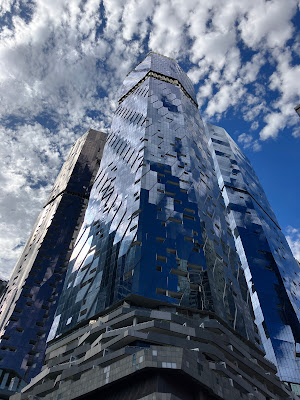After a too-short stay in Sydney, we flew down to Melbourne. We will be doing a lot of flying in Australia -- many people don't realize just how big this country is! It's about the same size as the U.S. so to drive from Sydney to Melbourne would be a journey of about 550 miles and take nine hours by car. It takes even longer by train, nearly 11 hours. It was much faster to take a 90 minute flight.
Melbourne is the second largest city in Australia, after Sydney. But here's a fun fact: neither city is the country's capital. In the early 1900's when the various territories decided to unite into the federated country of Australia, there was a heated rivalry over which of the two larger cities would be the capital. Rather than choose one over the other, the newly-formed commonwealth opted to split the difference distance-wise and build a brand new capital city at Canberra (which is about halfway between Melbourne and Sydney). Melbourne served as Australia’s temporary capital from 1901 to 1927 while the planned city of Canberra was being constructed.
For the next few days we are staying in an apartment on the 15th floor of a 64-floor high rise building. We’ve got some nice views to the west side of the city.
Melbourne is a blend of shiny modern skyscrapers and gorgeous old Victorian buildings like the State Library of Victoria, which was built in 1854 and is the oldest library in Australia.
If you've been following the blog for a while you probably already know that I love visiting libraries on our travels, and this one is exceptionally beautiful inside. The octagonal central reading room is topped by a glass dome that illuminates the enormous space and floods it with natural light.
In one of the side galleries was an exhibit on the history of the printed book. They had a beautiful volume of Audubon’s Birds of America on display.
And I was delighted to see an early printing of Michel de Montaigne’s Essays, one of my personal favorites.
We joined a walking tour that took us through several of Melbourne’s famous “laneways”. Many of these narrow pedestrian-only streets combine cafe and bar culture with street art. With so many cafes the laneways are a popular lunch spot, so you can have a meal while people-watching and looking around at all the interesting murals.
In fact, much of the city is covered in street art (don't call it grafitti!) and our tour guide informed us that artists who want to create a large-scale public art piece anywhere in the central business district have to get city council approval first. That's why the city has so many eye-catching murals like this one.
In contrast to the edgy, arty laneways, Melbourne’s covered shopping arcades are vestiges of the city’s elegant Victorian heyday. In the Block Arcade, we stopped into at a tea room that was established in 1892. The interior was richly decorated and magically transported us back to the gilded age.
Fancy!
We are looking forward to spending a few days here and enjoying the sights and history of this vibrant city.












No comments:
Post a Comment